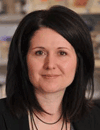Co-Located Conference AgendasFlow Chemistry Europe |  Other Track Agendas Other Track AgendasChemical Biology | Formulation and Solubility | Fragment Based Lead Discovery | Targeting Protein-Protein Interactions |

Tuesday, 19 March 201308:00 | Registration | |
Formulation Strategies | Session Sponsors |
| | 09:00 |  | Keynote Presentation CANCELLED - Understanding How Solution Conditions Affect Stability by Investigating Site-Specific Changes Within Proteins
Jennifer Laurence, Associate Professor, University of Kansas, United States of America
A novel peptide sequence that binds a metal ion and generates a unique peptide-metal complex having a negative charge and controlled release properties is being developed. We engineered this tag into a set of polypeptides and examined its ability to modulate solubility and stability. |
| 10:00 | Prediction of in vivo Performance during Formulation Development
Nikoletta Fotaki, Lecturer, University of Bath, United Kingdom
This talk will describe methods used for the prediction of the in vivo performance during formulation development. The factors that need to be taken into account for a predictive in vitro testing will be described and practices for successful predictions will be addressed. | 10:30 | Coffee and Networking in Exhibiton Hall | 11:15 |  | Keynote Presentation The Future of Formulation and Drug Delivery in Global Healthcare Provision
Sven Stegemann, Director, Capsugel, Belgium
The talk will address the impact of the changing healthcare with regard to emerging markets, patient populations, diagnostics, systems biology and personalized medicines. Looking from a holistic perspective, the future trends and directions are discussed. |
| 12:15 | Lunch and Networking in Exhibition Hall | 13:30 | Poster Viewing Session | 14:15 | Shear-stress Sensitive Lenticular Vesicles for Targeted Drug Delivery
Andreas Zumbuehl, Swiss National Science Foundation Professor, University of Fribourg, Switzerland
Drug carriers that can release drugs locally with such rheological changes can be very useful, e.g., for treating atherosclerosis. Here, we show that vesicles made from a artificial 1,3-diaminophospholipid are stable under static conditions but release their contents at elevated shear stress. | 14:45 | A Biodegradable Nanomaterial for in vivo Cell Tracking and Efficient Pro-survival/Angiogenic miRNA Delivery
Lino Ferreira, Principal Investigator, Biocant Center, Portugal
The ability to monitor transplanted cells in vivo by non-invasive imaging methods such as magnetic resonance imaging (MRI) and to simultaneously manipulate them by intracellular delivery of miRNAs is important in the context of regenerative medicine. The formulation reported here uses FDA-approved components, which should facilitate its biomedical translation. | 15:15 | Coffee and Networking in Exhibiton Hall | 16:00 | Tumour Regression after Intravenous Administration of Novel Targeted Anti-cancer Therapeutic Systems
Christine Dufes, Senior Lecturer, University of Strathclyde, United Kingdom
The possibility of using genes as medicines to treat cancer is limited by the lack of efficacious delivery systems able to selectively deliver genes to tumours. We demonstrated that the intravenous administration of a tumour-targeted dendriplex led to tumour disappearance of 90% of the tested tumours over one month. | 16:30 | Characterization Strategies for Metastable Drug Formulations
Eric Munson, Professor, University of Kentucky, United States of America
Advanced characterization techniques will be presented that focus on predicting whether metastable drug formulations, such as metastable polymorphs or amorphous formulations, will transform into their more stable form, resulting in reduced bioavailability and drug product failure. | |
Optimisation of Bioavailability Through Formulation |
| | 17:00 | Forcing the HIV Virus to Box Below its Weight Using Antiretroviral Nanomedicine
Steve Rannard, Group Leader & Vice Chair, University of Liverpool, United Kingdom
Nanomedicine formulations of antiretrovirals have been utilised to generate options for oral dosing of HIV patients. A detailed screening approach of material properties (size, charge, stabilisers), pharmacology, toxicology and in vivo studies have led to optimisation of materials with enhanced activity and bioavailability. | 17:30 | End of Day One |
Wednesday, 20 March 2013 |
Optimisation of Bioavailability Through Formulation Cont'd |
| | 10:00 | PASylation: the Biological Alternative to PEGylation
Uli Binder, Chief Technology Officer, XL Protein GmbH, Germany
Short plasma half-life is a major draw-back of most biopharmaceuticals, in particular small proteins and peptides, which can only in few cases be alleviated using depot formulations. Instead, PEGylation of biologics is now widely applied, but has disadvantages with regard to high production cost and tissue accumulation. We have developed PASylation, that is the genetic fusion of a biologic with a voluminous hydrophilic polypeptide composed of Pro, Ala, and/or Ser, as an efficient alternative technology to retard kidney filtration and design better drugs with prolonged action. | 10:30 | Coffee and Networking in Exhibiton Hall | 11:15 | A Simple, Once-a-day Dosage Form for the Delivery of Insulin Through the Nasal Route: in Vitro Assessment and in Vivo Evaluation
John Tsibouklis, Reader/Director, University of Portsmouth, United Kingdom
In vivo experiments (rat model) have demonstrated that an in situ thermogelling formulation of TMC is capable of residing at the nasal mucosa over time scales that far exceed that of mucus turnover. The same formulation has been shown to be capable of effecting the controlled delivery of insulin, as demonstrated by the in vivo (diabetic rat) reduction in blood glucose levels over 24 hours. | |
Modifying Solubility of Drug Compounds |
| | 11:45 | CANCELLED - Melt Extrusion Approached to Enhancing Drug Solubility
Gavin Andrews, Senior Lecturer, Queen's University of Belfast, United Kingdom
| 12:15 | Lunch and Networking in Exhibition Hall | 13:30 | Poster Viewing Session | 14:15 | Enhancing Drug Solubility through Phrase Separation/Coacervation and Spray Drying
Kamal Jonnalagadda, Associate Professor, University of the Sciences in Philadelphia, United States of America
Drug solubility is a function of its physical state. Amorphous structures show substantially higher solubility than crystalline polymorphs. The higher solubility comes at the expense of greater instability for amorphous compounds. This presentation will discuss two methods for preparing amorphous materials, and strategies to stabilize amorphous structures without compromising solubility. | |
Identifying Ways of Improving Drug Solubility |
| | 14:45 | Improved Uptake of Drugs for Cancer Treatment by Cyclodextrin Carriers
Gerhard Wenz, Professor, University of Saarland, Germany
The binding ability of CDs was increased by substitution of the primary hydroxyls with thioether groups. We synthesized a library of per-6-thio-6-deoxy-CDs, which are able to solubilize even very highly hydrophobic molecules, like C60 as well as betulin and camptothecin in water, potentially applicable for cancer treatment. | 15:15 | Coffee and Networking in Exhibiton Hall | 15:45 | Quantum Chemical and Machine Learning Calculations of the Intrinsic Aqueous Solubility of Druglike Molecules
John Mitchell, Lecturer/Head Scientist, University of Cambridge, United Kingdom
We show that the intrinsic aqueous solubility of crystalline druglike molecules can be computed with reasonable accuracy from crystal lattice simulations for the sublimation free energies, and the 3D Reference Interaction Site Model for hydration free energies. We compare these results with those obtained by machine learning. | 16:15 | Biopharmaceutical Evaluation of Poorly Soluble Drugs and Enabling Formulations
Martin Brandl, Professor, University of Southern Denmark, United States of America
Current paradigm of “enabling formulations” is: Poorly soluble drugs may upon solubilization show absorption profiles similar to soluble drugs. Therefore, formulation development aims at robust solubility enhancement. A critical review of common in-vitro approaches and experimental data on solubility / permeability of poorly soluble drugs from enabling formulations is presented. | 16:45 | Close of Conference |
|


 Add to Calendar ▼2013-03-19 00:00:002013-03-20 00:00:00Europe/LondonFormulation and SolubilitySELECTBIOenquiries@selectbiosciences.com
Add to Calendar ▼2013-03-19 00:00:002013-03-20 00:00:00Europe/LondonFormulation and SolubilitySELECTBIOenquiries@selectbiosciences.com